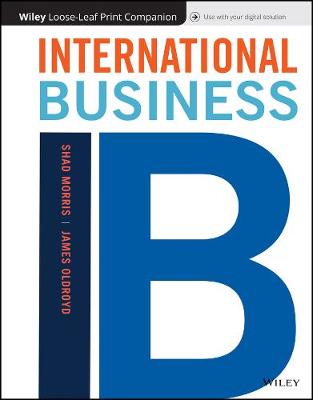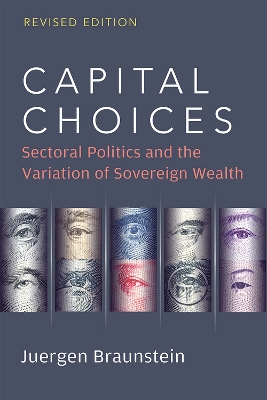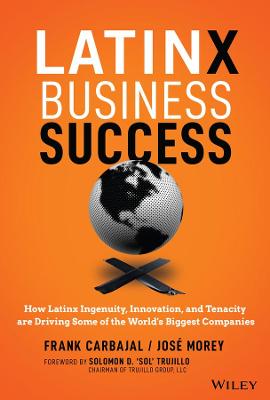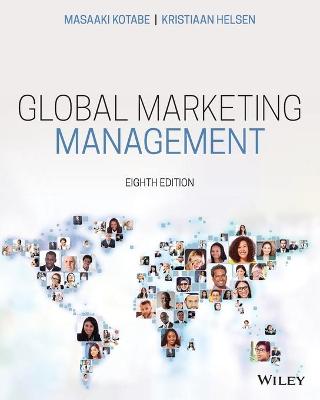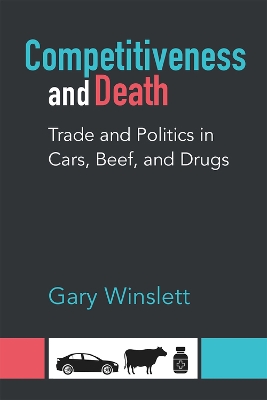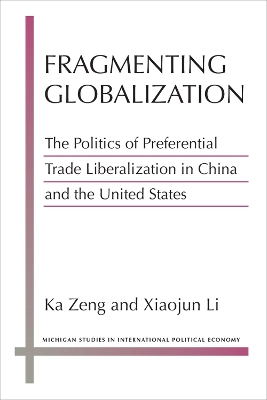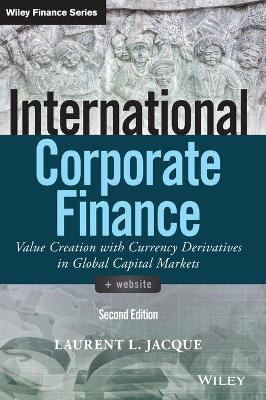International Business
International Business
Morris, Shad; Oldroyd, James
John Wiley & Sons Inc
06/2018
416
Loose-leaf
Inglês
9781119126645
806
Descrição não disponível.
About the Authors v Preface vi 1 Globalization 1 Introduction 1 1.1 What Is Globalization? 1 Globalization of Markets 3 Globalization of Production 5 1.2 The Flat World, Round World Globalization Debate 6 Both Sides of the Coin 8 1.3 Governing Globalization 9 1.4 Managing Globalization 12 Emerging Markets 12 Multinational Corporations 13 Summary 14 Case: Siri, Where Were You Made? 15 2 Analytical Tools for International Business 17 Introduction 17 2.1 Why International Business? 18 Increased Sales 19 New Resources 20 Reduced Risk 20 2.2 External Environment 22 Political Factors 22 Economic Factors 22 Sociocultural Factors 23 Technological Factors 23 Conducting a PEST Analysis 24 2.3 Internal Environment 25 Country Entry 25 Strategy 27 Organization 28 Leadership 28 Summary 29 Case: Toyota for the World 29 3 Political Systems 32 Introduction 32 3.1 The Political Spectrum 32 Individualism 33 Collectivism 33 Democratic Political Systems 33 Autocratic Political Systems 34 Communism and Socialism 35 Categorizing Political Systems 36 Mixed Political Systems 36 3.2 Political Risks 37 Macro Political Risk 37 Micro Political Risk 38 Direct and Indirect Effects of Political Risk 39 The Constant Challenge of Managing Political Risk 40 3.3 Measures of Political Freedom 41 The Freedom House and Heritage Foundation Measures 41 Implications of Political Freedom for International Business 43 Recent Political Trends That Affect Multinational Corporations 43 3.4 Government's Involvement in Business 46 When Governments Relax Their Policies 47 Summary 48 Case Study: Micro Political Risk and the Fast-Food Industry in Korea 48 4 The Legal Environment 52 Introduction 52 4.1 Differing Legal Systems 52 The Rule of Law 53 Three Different Levels of Law 54 Types of Legal Systems 55 International Law 56 The Effect of the Enforcement of Laws on International Business 58 4.2 Common Legal Issues for International Business 60 Increasing Wealth through Regulatory Changes 60 Product Liability 60 Property Rights and Intellectual Property 61 4.3 Illegal Versus Unethical Conduct 62 Ethics 63 International Business and a Reactive versus Proactive Response to Ethical Dilemmas 63 4.4 Important International Laws 65 The Foreign Corrupt Practices Act 65 e-Commerce and Data Privacy 67 Summary 67 Case Study: Can Korean Entertainment Content Companies Compete with Pirates? 68 5 Economic Systems 72 Introduction 72 5.1 Understanding Economic Systems 72 5.2 Measuring Output 75 Gross Domestic Product 76 Gross National Product 77 Other Measures of Prosperity and Opportunity 77 The Components of GDP 78 5.3 Governmental Economic Controls 81 Fiscal Policy 82 Monetary Policy 83 5.4 Currency Fluctuation and Concentration Effects 84 Purchasing Power Parity and the Law of One Price 85 The Gini Coefficient 86 Summary 89 Case Study: Comparing GDP Growth in China and India 90 6 Currency and Foreign Exchange 93 Introduction 93 6.1 What Is Money? 94 6.2 Understanding Exchange Rates 95 What Instituations Make Foreign Exchange Happen? 97 Determining Exchange Rates 99 Under- or Overvalued Currency 100 6.3 The Consequences of Under- or Overvalued Currencies for International Businesses 101 Undervalued Currency 101 Overvalued Currency 103 6.4 Understanding and Managing Exchange Rate Risk 103 Managing Exchange Rate Risks 105 Predicting Exchange Rate Shifts 106 Summary 107 Case Study: BMW and Foreign Exchange Rate Risk 108 7 Trade 110 Introduction 110 7.1 Theories of Trade 111 Interventionist Theories 111 Free-Trade Theories 112 Trade Pattern Theories 113 Using Trade Theory as a Global Manager 117 7.2 Trade Imbalances and Their Consequences 118 The Balance of Trade 118 Why Trade Imbalances Exist and Persist 119 What About the US Dollar and International Trade? 120 7.3 Patterns of Trade: Increased Regionalization 121 Global Integration 122 Policy Implications of the WTO 123 Bilateral Trade Agreements 123 Regional Trade Agreements 124 Other Forms of Trade Agreements 126 7.4 Government Policies Directed at Trade 126 Summary 129 Case Study: Globalization and the Fight to Keep 1,000 Carrier Jobs in Indiana 129 8 Culture 132 Introduction 132 8.1 What Is Culture? 132 What Is Culture? 133 Determinants of Culture 135 8.2 What Does Culture Mean for Business? 139 Social Stratification 139 Work Motivation 139 Relationship Preferences 140 Risk-Taking Behavior 141 Information 141 8.3 Managing Cultural Differences 142 Recognize Differences 142 Respect Differences 143 Reconcile Differences 143 8.4 Building Cultural Intelligence 144 Assessing Cultural Intelligence 145 Improving Cultural Intelligence 146 Summary 147 Case Study: A Cultural Challenge in Managing Ace Adams 147 9 Sustainability 150 Introduction 150 9.1 What Is Sustainability? 150 Climate Change 152 Resource Constraints 155 9.2 Fighting Short-Termism 156 Sources of Short-Termism 157 Fighting Short-Termism 157 9.3 Collaborating for Sustainability 159 Why Companies Want to Collaborate 159 How to Collaborate Successfully 161 9.4 Sustainability and Innovation 163 Stage 1: View Compliance as Opportunity 163 Stage 2: Make Value Chains Sustainable 163 Stage 3: Design Sustainable Products and Services 164 Stage 4: Develop New Business Models 165 Summary 166 Case Study: Patagonia Invests in Repair and Recycle 166 10 Poverty 169 Introduction 169 10.1 Causes and Consequences of Global Poverty 170 The Poverty Trap 171 Risks of Poverty 171 10.2 Traditional Responses to Poverty 174 Poverty Programs 174 Other Types of Organizations That Fight Poverty 176 Poverty Science 177 10.3 A Business Response to Poverty 177 The Poor as a Social Responsibility 178 The Poor as Profitable Clients 178 Base of the Pyramid Strategies 179 Reverse Innovation 181 The Poor as Entrepreneurial Producers 182 10.4 Doing Well and Doing Good 183 Summary 184 Case Study: Grameen Bank Considers Lending to the Non-Poor 184 11 Technological Change and Infrastructure 187 Introduction 187 11.1 Technology as Physical Infrastructure 188 Raw Materials 189 Manufacturing Equipment 189 Transportation Networks 190 Energy Resources 191 11.2 Technology of Information Infrastructure 194 Communication Technologies 195 Speed of the Internet 196 Peer-to-Peer and the Shared Economy 196 Data Storage and Processing Technologies 198 11.3 Technology of Human Infrastructure 200 Education 200 Corporate Training and Development 201 Industry, Education, and Government 202 11.4 Technology Trends in International Business 202 The Globalization of Research and Development 203 Summary 205 Case Study: LinkedIn in Brazil 206 12 Global Innovation and Intellectual Property 211 Introduction 211 12.1 Innovation as a Tool for Global Growth 212 Three Kinds of Innovation 212 Risks of Market-Creating Innovation 214 12.2 Investing in Innovation 215 From Local to Global Innovation 217 Innovation as a Human Capital Endeavor 218 12.3 Driving a Culture of Innovation 219 Foundations of Culture 219 The Innovator's Imperative 220 12.4 Protecting Intellectual Property 222 Patents 223 Advantages of Patents 224 Copyrights 225 Trademarks 225 Trade Secrets 226 International Bodies and Laws Governing IP 227 The Difficulty of Enforcement 227 Summary 228 Case: Mettler-Toledo: Measuring the Weight of Innovation 228 13 Country Selection and Entry Modes 232 Introduction 232 13.1 Deciding Which Foreign Markets to Enter 232 The Liability of Foreignness 233 First-Mover Advantage 234 Following Clients Globally 235 13.2 Entry Modes 236 Exporting 236 Turnkey Operations 239 Licensing 239 Franchising 241 Joint Ventures 243 Wholly Owned Subsidiary 244 13.3 Make, Ally, or Buy 245 Make 246 Ally 246 Buy 248 Summary 249 Case Study: Blendtec Goes Global Again 249 14 International Strategy 253 Introduction 253 14.1 What Is Strategy? 253 Value Creation and Capture 254 Strategic Positioning 254 Value Chain Analysis 256 14.2 Becoming Locally Responsive 258 Disadvantages of Being Locally Responsive 261 14.3 Achieving Global Integration 261 Advantages of Being Globally Integrated 262 Disadvantages of Being Globally Integrated 264 14.4 Choosing an International Strategy 265 Multidomestic Strategy 266 Meganational Strategy 266 Transnational Strategy 267 Summary 268 Case Study: Lincoln Electric's International Strategy 268 15 International Organizational Structures 271 Introduction 271 15.1 Types of Organizational Structures 272 Functional Structure 273 Divisional Structure 274 Matrix Structure 275 Network Structure 276 15.2 Informal Organizational Controls 278 Company Culture 278 Control Systems 279 Incentives as Control 282 15.3 Reducing the Need for Coordination among Subsidiaries: Virtual Organizations, Standards, and Modularity 283 Virtual Organizations 283 Technology Standards 284 Modularity 284 15.4 Horizontal Subsidiary Coordination 286 Summary 287 Case Study: Control at Zara 288 16 Global Leadership 291 Introduction 291 16.1 What Is Global Leadership? 291 The Global Context of Leadership 292 The Need for Global Leadership 292 16.2 Global Leadership Competencies 294 General Competencies 295 Company-Related Competencies 297 Location-Related Competencies 298 16.3 Building Global Leadership Competencies in Others 299 16.4 Building Global Leadership Competencies in Yourself 301 Find Academic Environments That Encourage Global Development 301 Seek Opportunities at Work and Ask for Help 301 Be Patient and Flexible 303 Summary 303 Case Study: Honeywell Identifies Future Leadership Needs 304 17 Global Marketing 307 Introduction 307 17.1 Global Market Segmentation 307 17.2 Standardization Versus Differentiation in International Marketing 309 Standardization of the Marketing Mix 310 Differentiation of the Marketing Mix 311 Glocalization 312 17.3 Global Branding 313 Building Brand Awareness 314 Brand Image 316 Brand Loyalty 316 Brand Equity 316 Benefits of a Global Brand 317 Downsides of a Global Brand 317 17.4 Global Pricing and Distribution 317 General Pricing Strategies 317 Other Factors Affecting Global Pricing 319 Distribution Strategies 321 Summary 322 Case Study: Peaks Sends Kilimanjaro to Brazil 323 18 Global Operations and Supply-Chain Management 326 Introduction 326 18.1 Global Procurement 326 Advantages of Global Procurement 328 Disadvantages of Global Procurement 329 Outsourcing and Offshoring 330 18.2 Global Production 331 Advantages of Making 331 Disadvantages of Making 332 Location 332 Relocation 336 18.3 Global Supply Chains 336 Improving Global Supply-Chain Management 338 Information Technologies 338 18.4 Using Data Analytics to Improve Supply Chains 340 Applications of Data Analytics 341 Improving Performance 341 Summary 343 Case Study: Boeing in China 344 19 Global Human Resource Management 346 Introduction 346 19.1 The Global HR Wheel 346 Human Capital Portfolios 347 HR Practices 348 Focusing on Organizational Outcomes 350 19.2 Human Capital in the Global Context 351 Local Human Capital 351 Subsidiary Human Capital 352 Corporate Human Capital 353 International Human Capital 354 19.3 Meeting Strategic Objectives Through Human Capital 354 The Multidomestic Strategy 355 The Meganational Strategy 356 The Transnational Strategy 357 19.4 Tasks of the Global HR Function 358 Contributing to Business Decision Making 359 Providing HR Expertise 359 Delivering HR Services 361 Summary 361 Case Study: Intel's Search for Talent in Vietnam 362 20 Global Finance and Accounting 365 Introduction 365 20.1 Financing International Trade and Investment 365 International Banking 366 International Bond Markets 369 International Stock Markets 370 20.2 Capital Budgeting for Multinational Companies 373 The Parent Firm's Capital Budgeting Decisions 373 The Cost of Capital: Domestic versus Global 374 20.3 International Accounting Standards 375 Generally Accepted Accounting Principles 375 International Financial Reporting Standards 376 20.4 Global Tax Matters 376 Corporate Income Tax 377 Transfer Pricing 378 Chapter Summary 379 Case Study: GlaxoSmithKline: What's the Right Price to Pay? 380 GLOSSARY 382 Index 389
Este título pertence ao(s) assunto(s) indicados(s). Para ver outros títulos clique no assunto desejado.
Morris; International Business; Morris International Business; Morris International Business 1e
About the Authors v Preface vi 1 Globalization 1 Introduction 1 1.1 What Is Globalization? 1 Globalization of Markets 3 Globalization of Production 5 1.2 The Flat World, Round World Globalization Debate 6 Both Sides of the Coin 8 1.3 Governing Globalization 9 1.4 Managing Globalization 12 Emerging Markets 12 Multinational Corporations 13 Summary 14 Case: Siri, Where Were You Made? 15 2 Analytical Tools for International Business 17 Introduction 17 2.1 Why International Business? 18 Increased Sales 19 New Resources 20 Reduced Risk 20 2.2 External Environment 22 Political Factors 22 Economic Factors 22 Sociocultural Factors 23 Technological Factors 23 Conducting a PEST Analysis 24 2.3 Internal Environment 25 Country Entry 25 Strategy 27 Organization 28 Leadership 28 Summary 29 Case: Toyota for the World 29 3 Political Systems 32 Introduction 32 3.1 The Political Spectrum 32 Individualism 33 Collectivism 33 Democratic Political Systems 33 Autocratic Political Systems 34 Communism and Socialism 35 Categorizing Political Systems 36 Mixed Political Systems 36 3.2 Political Risks 37 Macro Political Risk 37 Micro Political Risk 38 Direct and Indirect Effects of Political Risk 39 The Constant Challenge of Managing Political Risk 40 3.3 Measures of Political Freedom 41 The Freedom House and Heritage Foundation Measures 41 Implications of Political Freedom for International Business 43 Recent Political Trends That Affect Multinational Corporations 43 3.4 Government's Involvement in Business 46 When Governments Relax Their Policies 47 Summary 48 Case Study: Micro Political Risk and the Fast-Food Industry in Korea 48 4 The Legal Environment 52 Introduction 52 4.1 Differing Legal Systems 52 The Rule of Law 53 Three Different Levels of Law 54 Types of Legal Systems 55 International Law 56 The Effect of the Enforcement of Laws on International Business 58 4.2 Common Legal Issues for International Business 60 Increasing Wealth through Regulatory Changes 60 Product Liability 60 Property Rights and Intellectual Property 61 4.3 Illegal Versus Unethical Conduct 62 Ethics 63 International Business and a Reactive versus Proactive Response to Ethical Dilemmas 63 4.4 Important International Laws 65 The Foreign Corrupt Practices Act 65 e-Commerce and Data Privacy 67 Summary 67 Case Study: Can Korean Entertainment Content Companies Compete with Pirates? 68 5 Economic Systems 72 Introduction 72 5.1 Understanding Economic Systems 72 5.2 Measuring Output 75 Gross Domestic Product 76 Gross National Product 77 Other Measures of Prosperity and Opportunity 77 The Components of GDP 78 5.3 Governmental Economic Controls 81 Fiscal Policy 82 Monetary Policy 83 5.4 Currency Fluctuation and Concentration Effects 84 Purchasing Power Parity and the Law of One Price 85 The Gini Coefficient 86 Summary 89 Case Study: Comparing GDP Growth in China and India 90 6 Currency and Foreign Exchange 93 Introduction 93 6.1 What Is Money? 94 6.2 Understanding Exchange Rates 95 What Instituations Make Foreign Exchange Happen? 97 Determining Exchange Rates 99 Under- or Overvalued Currency 100 6.3 The Consequences of Under- or Overvalued Currencies for International Businesses 101 Undervalued Currency 101 Overvalued Currency 103 6.4 Understanding and Managing Exchange Rate Risk 103 Managing Exchange Rate Risks 105 Predicting Exchange Rate Shifts 106 Summary 107 Case Study: BMW and Foreign Exchange Rate Risk 108 7 Trade 110 Introduction 110 7.1 Theories of Trade 111 Interventionist Theories 111 Free-Trade Theories 112 Trade Pattern Theories 113 Using Trade Theory as a Global Manager 117 7.2 Trade Imbalances and Their Consequences 118 The Balance of Trade 118 Why Trade Imbalances Exist and Persist 119 What About the US Dollar and International Trade? 120 7.3 Patterns of Trade: Increased Regionalization 121 Global Integration 122 Policy Implications of the WTO 123 Bilateral Trade Agreements 123 Regional Trade Agreements 124 Other Forms of Trade Agreements 126 7.4 Government Policies Directed at Trade 126 Summary 129 Case Study: Globalization and the Fight to Keep 1,000 Carrier Jobs in Indiana 129 8 Culture 132 Introduction 132 8.1 What Is Culture? 132 What Is Culture? 133 Determinants of Culture 135 8.2 What Does Culture Mean for Business? 139 Social Stratification 139 Work Motivation 139 Relationship Preferences 140 Risk-Taking Behavior 141 Information 141 8.3 Managing Cultural Differences 142 Recognize Differences 142 Respect Differences 143 Reconcile Differences 143 8.4 Building Cultural Intelligence 144 Assessing Cultural Intelligence 145 Improving Cultural Intelligence 146 Summary 147 Case Study: A Cultural Challenge in Managing Ace Adams 147 9 Sustainability 150 Introduction 150 9.1 What Is Sustainability? 150 Climate Change 152 Resource Constraints 155 9.2 Fighting Short-Termism 156 Sources of Short-Termism 157 Fighting Short-Termism 157 9.3 Collaborating for Sustainability 159 Why Companies Want to Collaborate 159 How to Collaborate Successfully 161 9.4 Sustainability and Innovation 163 Stage 1: View Compliance as Opportunity 163 Stage 2: Make Value Chains Sustainable 163 Stage 3: Design Sustainable Products and Services 164 Stage 4: Develop New Business Models 165 Summary 166 Case Study: Patagonia Invests in Repair and Recycle 166 10 Poverty 169 Introduction 169 10.1 Causes and Consequences of Global Poverty 170 The Poverty Trap 171 Risks of Poverty 171 10.2 Traditional Responses to Poverty 174 Poverty Programs 174 Other Types of Organizations That Fight Poverty 176 Poverty Science 177 10.3 A Business Response to Poverty 177 The Poor as a Social Responsibility 178 The Poor as Profitable Clients 178 Base of the Pyramid Strategies 179 Reverse Innovation 181 The Poor as Entrepreneurial Producers 182 10.4 Doing Well and Doing Good 183 Summary 184 Case Study: Grameen Bank Considers Lending to the Non-Poor 184 11 Technological Change and Infrastructure 187 Introduction 187 11.1 Technology as Physical Infrastructure 188 Raw Materials 189 Manufacturing Equipment 189 Transportation Networks 190 Energy Resources 191 11.2 Technology of Information Infrastructure 194 Communication Technologies 195 Speed of the Internet 196 Peer-to-Peer and the Shared Economy 196 Data Storage and Processing Technologies 198 11.3 Technology of Human Infrastructure 200 Education 200 Corporate Training and Development 201 Industry, Education, and Government 202 11.4 Technology Trends in International Business 202 The Globalization of Research and Development 203 Summary 205 Case Study: LinkedIn in Brazil 206 12 Global Innovation and Intellectual Property 211 Introduction 211 12.1 Innovation as a Tool for Global Growth 212 Three Kinds of Innovation 212 Risks of Market-Creating Innovation 214 12.2 Investing in Innovation 215 From Local to Global Innovation 217 Innovation as a Human Capital Endeavor 218 12.3 Driving a Culture of Innovation 219 Foundations of Culture 219 The Innovator's Imperative 220 12.4 Protecting Intellectual Property 222 Patents 223 Advantages of Patents 224 Copyrights 225 Trademarks 225 Trade Secrets 226 International Bodies and Laws Governing IP 227 The Difficulty of Enforcement 227 Summary 228 Case: Mettler-Toledo: Measuring the Weight of Innovation 228 13 Country Selection and Entry Modes 232 Introduction 232 13.1 Deciding Which Foreign Markets to Enter 232 The Liability of Foreignness 233 First-Mover Advantage 234 Following Clients Globally 235 13.2 Entry Modes 236 Exporting 236 Turnkey Operations 239 Licensing 239 Franchising 241 Joint Ventures 243 Wholly Owned Subsidiary 244 13.3 Make, Ally, or Buy 245 Make 246 Ally 246 Buy 248 Summary 249 Case Study: Blendtec Goes Global Again 249 14 International Strategy 253 Introduction 253 14.1 What Is Strategy? 253 Value Creation and Capture 254 Strategic Positioning 254 Value Chain Analysis 256 14.2 Becoming Locally Responsive 258 Disadvantages of Being Locally Responsive 261 14.3 Achieving Global Integration 261 Advantages of Being Globally Integrated 262 Disadvantages of Being Globally Integrated 264 14.4 Choosing an International Strategy 265 Multidomestic Strategy 266 Meganational Strategy 266 Transnational Strategy 267 Summary 268 Case Study: Lincoln Electric's International Strategy 268 15 International Organizational Structures 271 Introduction 271 15.1 Types of Organizational Structures 272 Functional Structure 273 Divisional Structure 274 Matrix Structure 275 Network Structure 276 15.2 Informal Organizational Controls 278 Company Culture 278 Control Systems 279 Incentives as Control 282 15.3 Reducing the Need for Coordination among Subsidiaries: Virtual Organizations, Standards, and Modularity 283 Virtual Organizations 283 Technology Standards 284 Modularity 284 15.4 Horizontal Subsidiary Coordination 286 Summary 287 Case Study: Control at Zara 288 16 Global Leadership 291 Introduction 291 16.1 What Is Global Leadership? 291 The Global Context of Leadership 292 The Need for Global Leadership 292 16.2 Global Leadership Competencies 294 General Competencies 295 Company-Related Competencies 297 Location-Related Competencies 298 16.3 Building Global Leadership Competencies in Others 299 16.4 Building Global Leadership Competencies in Yourself 301 Find Academic Environments That Encourage Global Development 301 Seek Opportunities at Work and Ask for Help 301 Be Patient and Flexible 303 Summary 303 Case Study: Honeywell Identifies Future Leadership Needs 304 17 Global Marketing 307 Introduction 307 17.1 Global Market Segmentation 307 17.2 Standardization Versus Differentiation in International Marketing 309 Standardization of the Marketing Mix 310 Differentiation of the Marketing Mix 311 Glocalization 312 17.3 Global Branding 313 Building Brand Awareness 314 Brand Image 316 Brand Loyalty 316 Brand Equity 316 Benefits of a Global Brand 317 Downsides of a Global Brand 317 17.4 Global Pricing and Distribution 317 General Pricing Strategies 317 Other Factors Affecting Global Pricing 319 Distribution Strategies 321 Summary 322 Case Study: Peaks Sends Kilimanjaro to Brazil 323 18 Global Operations and Supply-Chain Management 326 Introduction 326 18.1 Global Procurement 326 Advantages of Global Procurement 328 Disadvantages of Global Procurement 329 Outsourcing and Offshoring 330 18.2 Global Production 331 Advantages of Making 331 Disadvantages of Making 332 Location 332 Relocation 336 18.3 Global Supply Chains 336 Improving Global Supply-Chain Management 338 Information Technologies 338 18.4 Using Data Analytics to Improve Supply Chains 340 Applications of Data Analytics 341 Improving Performance 341 Summary 343 Case Study: Boeing in China 344 19 Global Human Resource Management 346 Introduction 346 19.1 The Global HR Wheel 346 Human Capital Portfolios 347 HR Practices 348 Focusing on Organizational Outcomes 350 19.2 Human Capital in the Global Context 351 Local Human Capital 351 Subsidiary Human Capital 352 Corporate Human Capital 353 International Human Capital 354 19.3 Meeting Strategic Objectives Through Human Capital 354 The Multidomestic Strategy 355 The Meganational Strategy 356 The Transnational Strategy 357 19.4 Tasks of the Global HR Function 358 Contributing to Business Decision Making 359 Providing HR Expertise 359 Delivering HR Services 361 Summary 361 Case Study: Intel's Search for Talent in Vietnam 362 20 Global Finance and Accounting 365 Introduction 365 20.1 Financing International Trade and Investment 365 International Banking 366 International Bond Markets 369 International Stock Markets 370 20.2 Capital Budgeting for Multinational Companies 373 The Parent Firm's Capital Budgeting Decisions 373 The Cost of Capital: Domestic versus Global 374 20.3 International Accounting Standards 375 Generally Accepted Accounting Principles 375 International Financial Reporting Standards 376 20.4 Global Tax Matters 376 Corporate Income Tax 377 Transfer Pricing 378 Chapter Summary 379 Case Study: GlaxoSmithKline: What's the Right Price to Pay? 380 GLOSSARY 382 Index 389
Este título pertence ao(s) assunto(s) indicados(s). Para ver outros títulos clique no assunto desejado.

